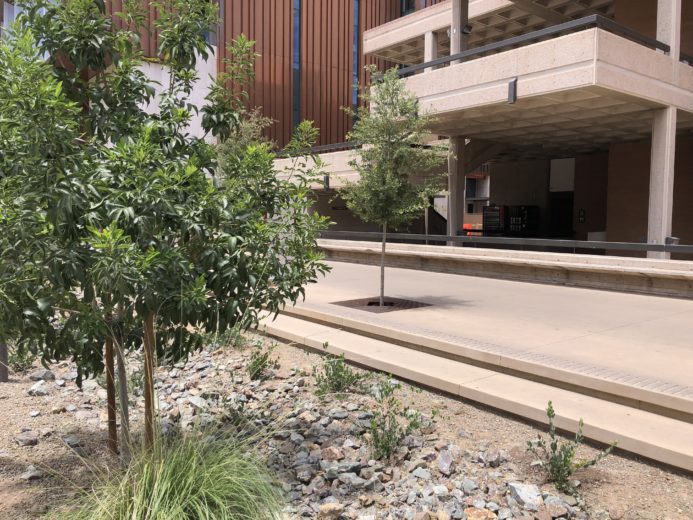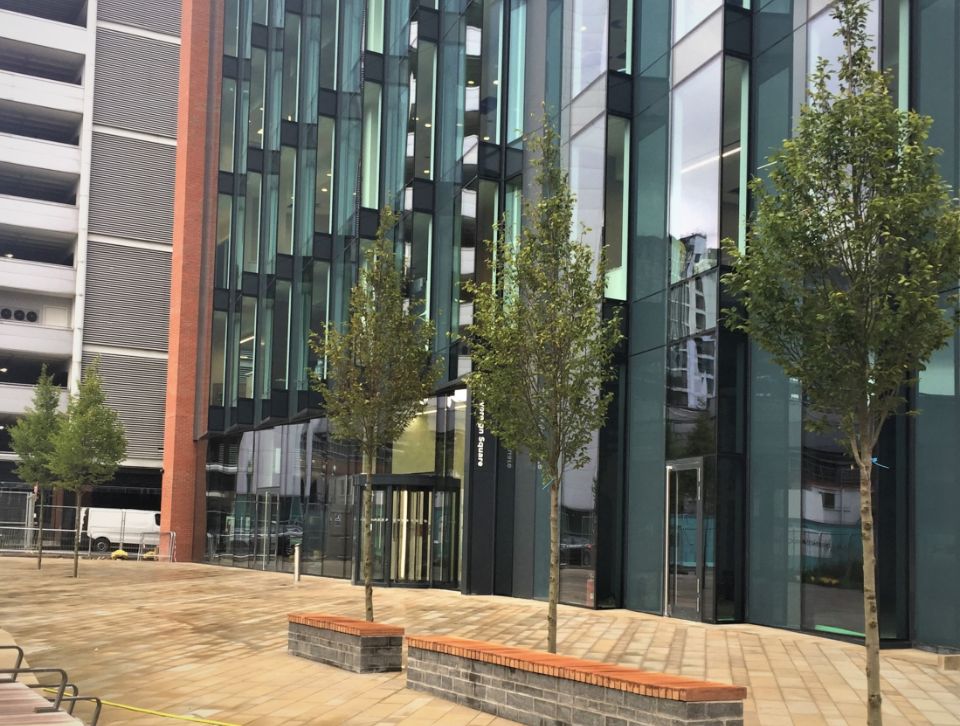
– Arizona State University (ASU) prioritizes trees, soil health, and landscape architecture.
– Surveys by the landscape architecture department at ASU found that students overwhelmingly wanted shade and reduced temperature as their landscape priority.
– ASU’s Tempe campus instituted a masterplan for landscape architecture in 2017. From the masterplan came two redesign projects, both of which included Silva Cells: first, the student pavilion (Orange Mall), which added 16 trees; and second, the plaza at Sun Devil Stadium, which now has 19 trees.
– Combined there are 564 1X, 2X, and 3X Silva Cells, and 6,144 ft3 of soil volume supporting campus trees and ensuring shade.
Arizona State University has four campuses in the greater Phoenix metro area. Student enrolment at ASU grew nearly 60% in the early 2000s; as a result, a rethink of landscape architecture became a priority. Associate director Byron Sampson PLA, ASLA, and project manager-landscape Norman Yatabe PLA, ASLA, LEED AP, of the FDM Office of University Architect at ASU, are responsible for “every bit of open space on all four campuses – any [flora] that is 5 feet (1.5m) outside of any building,” as Byron puts it.
Byron and Norman are ASU’s first staff landscape architects and have been working together for 11 years. Their roles encompass campus landscape development, planning, and guiding design professionals. They are involved in everything from conceptual design to construction on many of the site development projects at ASU.
Orange Mall was awarded a LEED Gold Sustainable Site. Every new building on campus is required to be LEED Silver, and Norman and Byron believe that campus landscape should be of an equally high standard.
Arizona’s desert heat is no secret. It’s hot, dry summers can reach temperatures above 100oF (38oC), and research shows that the cooling effect from shade can lower temperatures anywhere from 15-20oF. During the planning phase of the 2017 Tempe Campus Hardscape Master Plan, ASU students were asked what they want most from their campus landscape. The overwhelming, and unsurprising, response was “shade.” Thus, the Master Plan would include shade by ensuring trees that would grow into large canopies, thereby providing cooling capabilities.
DeepRoot spoke with Byron and Norman about the Orange Mall project; both said they were always familiar with Silva Cell systems but did not have an opportunity to incorporate the technology until 2017. Structural soil was specified on a variety of their early projects at ASU. However, it didn’t yield the results that the landscape architecture team wanted to see. “Structural soil would dry out and not hold the level of polymer we needed. If we had to replace a tree, the tree and the structural soil had to be removed. The problem was recurring. The Orange Mall project was the earliest opportunity to incorporate Silva Cells, so we advocated for them,” Byron explained.

Image 1: Silva Cells are installed below Live Oak (Quercus Virginiana) and Red Push Pistache (Pistacia) trees in bioswales. All trees but the palms are in Silva Cells in this photo. Photo courtesy of Colwell Shelor Landscape Architecture.
– Six Pink Dawn (Chitalpa Tashkentensis) line the building’s entrance.
– Three Fanwest Ash (Fraxinus v ‘fanwest’) opposite and diagonal from the building’s entrance.
– Four Live Oak (Quercus Virginiana) (see Image 1) in and beside bioswales adjacent to the walkway.
– Three Red Push Pistache (Pistacia x Red Push) opposite the four Live Oak trees (photographed in Image 1).
Arizona’s monsoon season typically begins in June, bringing with it an average rainfall of 5 inches (13cm), but Arizona has experienced several consecutive dry years since 2000. To preserve rainfall during monsoon season, landscape architect Colwell Shelor added a series of connected bioswales among the trees — all of which are supported by Silva Cells. The Orange Mall project highlights Silva Cells’ efficiency and abilities in both arid conditions and during intense flooding, demonstrating their ability to support trees, manage excess water, and store the little water that does fall throughout the year and during dry monsoons.
Colwell Shelor designed the roof so that water is funnelled downwards and into planters adjacent to the face of the building. Excess water collected during monsoon rains soaks the trees and bioswale gardens.

Image 2 (above) and image 3 (below): Silva Cell installation at Orange Mall.
Photo courtesy of Colwell Shelor Landscape Architecture.




Image 6: Photo courtesy of Colwell Shelor Landscape Architecture.
“We wouldn’t have gotten the plant growth we saw without the Silva Cell system.”
– Byron Sampson, associate director, FDM Office of University Architect

Image 7: December 2019, one-and-a-half years after installation.
In 2018, a highly anticipated renovation began on the plaza at Sun Devil Stadium. Built in 1958 with a seating capacity of 30,000, after a number of upgrades the stadium can now host up to 54,000 fans. Shade and cooling temperatures outside the stadium plaza were a top priority under the 2017 Master Plan. Image 8: Photo courtesy of AECOM.
Image 8: Photo courtesy of AECOM.
“We saw that the Orange Mall extension showed growth rate on the trees and thought, ‘this is working, this is successful, there is no reason not to do this again.’”
– Byron Sampson, associate director, FDM Office of University Architect
Live Oak, Chinese Pistache, and Chitalpa are among the trees incorporated into the regeneration of Sun Devil Stadium’s plaza landscape. Each tree received a dedicated number of Silva Cells. For the entire project 306 (2X) were installed to give 405 cubic feet (11.5M3) of soil volume. The trees are scattered around the plaza space and along 500 East Veterans Way. DTR Landscape installed the Silva Cells in May 2018. Below are the before and after photos, as well as photos of the trees a year after installation.
Prioritizing the long-term health and equity of campus landscape created a winning scenario at ASU Tempe that will benefit many generations of students. Utilizing Silva Cells allows for proper stormwater management for the often intense monsoon rains in Tempe, as well as drought-stricken seasons.
Silva Cells supporting more than 30 trees on the ASU campus, and thousands of cubic feet of soil volume is an exciting step for ASU’s landscape architecture.

Image 9: Installation of Silva Cells at Sun Devil Stadium plaza in May 2018.

Image 10: Installation of 2X Silva Cells along Veterans Way in May 2018.

Image 11: Several Live Oak trees along 500 Veterans Way in December 2019.
Installation Summary:
Number of Silva Cells: Orange Mall: 54 1X, 204 2X
Sun Devil Stadium plaza: 306 2X
Soil Volume: Orange Mall: 5,739 ft3 (162.5M3) soil
Sun Devil Stadium plaza: 405 ft3 (11.5M3) per tree
Number of Trees: Orange Mall: 16 trees
Sun Devil Stadium plaza: 19 trees
Type of Project: University campus pavilion and stadium plaza
Project Designer: Orange Mall: Colwell Shelor
Sun Devil Stadium plaza: GBtwo Landscape Architecture, Inc.
Project Contractor: Sun Devil Stadium: DTR Landscape
Installation Date of Silva Cells: Orange Mall: June 2017
Sun Devil Stadium plaza: May 2018
Project Timeline: 2017-2019
*header image courtesy of Colwell Shelor
